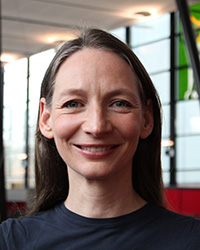Meet the spatial biologists
Leadership Team

Prof Francesca Ciccarelli
Francesca Ciccarelli studies the drivers of cancer evolution from tumour initiation to response to therapy. Her lab uses spatial transcriptomics and proteomics coupled with high-resolution tissue imaging to understand how genetic alterations within tumours affect their function and to analyse the composition of the local microenvironment.
🔬 Cancer
🧬 Human, Mouse
🕹️ 10x Genomics Visium, Imaging Mass Cytometry, Nanostring CosMX

Prof Stuart McDonald
Stuart McDonald's expertise is in stem cell biology and understanding the evolution of premalignant disease to cancer. His lab has used spatial biology to investigate the progression to cancer in conditions such as Barrett’s oesophagus. They are currently developing immune signatures that can be used to identify preprogressive immune alterations.
✉️ s.a.mcdonald@qmul.ac.uk
🔬 Cancer
🧬 Human
🕹️ Leica CellDive, Nanostring GeoMX, Phenocycler Fusion

Dr Inês Sequeira
Inês Sequeira is interested in dissecting the biological mechanisms involved in oral cancer formation and in understanding the regenerative potential of the oral mucosa, a tissue with rapid and scarless healing. Her team leverages spatial biology approaches to map cellular interactions and uncover signals during oral wound healing and tumour formation.
✉️ i.sequeira@qmul.ac.uk
🔬 Cancer, Skin disease, Development, Inflammation, Regeneration
🧬 Human, Mouse
🕹️ 10x Genomics Xenium, Phenocycler Fusion, Stereo-Seq, Vizgen Merscope
Facility managers
Phenotypic Screening Facility
Dr Luke Gammon
 Having taken over managing the phenotypic screening facility back in 2013 Luke has over 10 years of experience working with high content imaging analysis software and high-throughput screening platforms. In 2022 the facility added the Cell DIVE slide scanning multiplex system and HALO analysis software being the first to have such a system outside the US. The facility has since expanded its spatial platforms with automated multiplex stainers and the new Phenocycler Fusion 2.0 ultra high plex system. The facility supports several large internal and external projects.
Having taken over managing the phenotypic screening facility back in 2013 Luke has over 10 years of experience working with high content imaging analysis software and high-throughput screening platforms. In 2022 the facility added the Cell DIVE slide scanning multiplex system and HALO analysis software being the first to have such a system outside the US. The facility has since expanded its spatial platforms with automated multiplex stainers and the new Phenocycler Fusion 2.0 ultra high plex system. The facility supports several large internal and external projects.
Genome Centre
Dr Charles Mein
 Charles heads the QMUL Genome Centre, which supports spatial transcriptome analysis at a range of different scales. As a certified provider of 10x Genomics chemistry, the Centre has run projects focused on Visium full transcriptome analysis since 2021, and has more recently implemented the Visium HD array. For morphology targeted transcriptome analysis the facility can deploy the Nanostring GeoMX platform and sub cellular transcriptome analysis is possible with the Nanostring CosMX. Each of these platforms can also be used to analyse panels of proteins.
Charles heads the QMUL Genome Centre, which supports spatial transcriptome analysis at a range of different scales. As a certified provider of 10x Genomics chemistry, the Centre has run projects focused on Visium full transcriptome analysis since 2021, and has more recently implemented the Visium HD array. For morphology targeted transcriptome analysis the facility can deploy the Nanostring GeoMX platform and sub cellular transcriptome analysis is possible with the Nanostring CosMX. Each of these platforms can also be used to analyse panels of proteins.
Academics
 Adrian Biddle is a Reader in Cancer Biology, with an interest in cancer stem cells (CSCs) in oral cancer. CSCs drive tumour spread and therapeutic resistance, with their phenotype and behaviours controlled by important interactions with the tumour microenvironment (TME). There is therefore an important role for spatial biology approaches to help us understand and target the heterocellular interactions between CSCs and the TME.
Adrian Biddle is a Reader in Cancer Biology, with an interest in cancer stem cells (CSCs) in oral cancer. CSCs drive tumour spread and therapeutic resistance, with their phenotype and behaviours controlled by important interactions with the tumour microenvironment (TME). There is therefore an important role for spatial biology approaches to help us understand and target the heterocellular interactions between CSCs and the TME.
✉️ a.biddle@qmul.ac.uk
🔬 Cancer
🧬 Human
🕹️ 10x Genomics Visium, Leica CellDive, Nanostring CosMX
 Through the use of multiplex microscopy Cleo Bishop's lab is probing the heterogeneity of senescence and exploring novel routes to understanding senescence, ageing and cancer. They use a range of 2D and 3D models as well as human tissue to explore these aspects of biology at the single cell level.
Through the use of multiplex microscopy Cleo Bishop's lab is probing the heterogeneity of senescence and exploring novel routes to understanding senescence, ageing and cancer. They use a range of 2D and 3D models as well as human tissue to explore these aspects of biology at the single cell level.
🔬 Cancer, Tissue regeneration, Ageing and senescence, Skin, Kidney, Breast
🧬 Human
🕹️ Leica CellDIVE
 Ana Caetano's lab studies the nervous system of the oral mucosa to understand how its development, architecture, and function may influence cell fate acquisition and disease mechanisms. Their work tries to identify the molecular signals involved in the development, maturation and dysregulation of elaborate networks of neurons and glia. To do this, they use a wide range of experimental strategies, including various spatial genomics approaches and state-of-the-art imaging.
Ana Caetano's lab studies the nervous system of the oral mucosa to understand how its development, architecture, and function may influence cell fate acquisition and disease mechanisms. Their work tries to identify the molecular signals involved in the development, maturation and dysregulation of elaborate networks of neurons and glia. To do this, they use a wide range of experimental strategies, including various spatial genomics approaches and state-of-the-art imaging.
🔬 Cancer, Development, Inflammation, Neuroscience, Tissue Regeneration
🧬 Human, Mouse
🕹️ 10x Genomics Visium, Leica CellDive, Nanostring CosMX
Paul Chapple is a cell biologist whose research has concentrated on understanding the role of cellular stress and molecular chaperones in health and disease, with a focus on neuronal and endocrine systems. This has included studies of multiple rare diseases and in particular neurodegenerative disorder, including through multi-omic approaches. His lab is currently applying spatial transcriptomics to investigate disruption of proteostasis in the brain and how this links to neurodegeneration.
🔬 Cancer, Neuroscience
🧬 Human, Mouse
🕹️ Vizgen Merscope
 Özgen Deniz's group focuses on understanding the epigenetic regulation of transposable elements and how their dysregulation contribute to the generation and development of blood cancers. They are beginning to explore how these tools can provide deeper insights into cellular interactions and molecular dynamics in the context of Acute Myeloid Leukemia to better understand the biology of this disease with specific focus on transposon activation and immune responses.
Özgen Deniz's group focuses on understanding the epigenetic regulation of transposable elements and how their dysregulation contribute to the generation and development of blood cancers. They are beginning to explore how these tools can provide deeper insights into cellular interactions and molecular dynamics in the context of Acute Myeloid Leukemia to better understand the biology of this disease with specific focus on transposon activation and immune responses.
✉️ o.deniz@qmul.ac.uk
🔬 Cancer
🧬 Human

🔬 Cancer
🧬 Human
🕹️ 10x Genomics Visium, Leica CellDive
John Marshall studies the biology of tumour invasion with a particular interest in the roles of the adhesion molecules expressed on the cell surface that mediate this process. He supervises multiplex immunofluorescence analyses and has implemented HALO AI as an image analysis tool.
✉️ j.f.marshall@qmul.ac.uk
🔬 Cancer, Cutaneous Disease
🧬 Human, Mouse
🕹️ Leica CellDive, Standard BioTools Hyperion
James Timmons has been working with transcriptomics for 20 years (laboratory and informatics). Since 2023 he has worked with GeoMX, Xenium and Merscope. His lab is applying spatial analysis to human musculoskeletal tissues and mouse Central Nervous System. They are contrasting network methods applied to large scale bulk transcriptomics profiles with bespoke spatial gene panels, examining the role of rarer cells types involved in tissue remodelling in aging and metabolic diseases.
✉️ j.timmons@qmul.ac.uk
🔬 Neuroscience, Skeletal, Tissue Regeneration
🧬 Human, Mouse
🕹️ 10x Genomics Xenium, Nanostring GeoMX, Vizgen Merscope
 Alex Wang leads a bioinformatics lab who is interested in applying novel analytic algorithms to analyse spatial omics data, with a specific interest in squamous cell carcinoma (SCC). In particular, his lab is interested in identifying dysregulated immune populations and novel tumour and immune links associated with disease progression and metastasis of cutaneous SCC, so that targets to improve the efficacy of immunotherapy may be identified. They use spatial transcriptomics, multiplex IHC and digital pathology to profile our clinical samples.
Alex Wang leads a bioinformatics lab who is interested in applying novel analytic algorithms to analyse spatial omics data, with a specific interest in squamous cell carcinoma (SCC). In particular, his lab is interested in identifying dysregulated immune populations and novel tumour and immune links associated with disease progression and metastasis of cutaneous SCC, so that targets to improve the efficacy of immunotherapy may be identified. They use spatial transcriptomics, multiplex IHC and digital pathology to profile our clinical samples.
✉️ j.a.wang@qmul.ac.uk
🔬 Cancer, Cutaneous disease
🧬 Human
🕹️ 10x Genomics Visium, 10x Genomics Visium HD, Leica CellDive, Nanostring GeoMX
